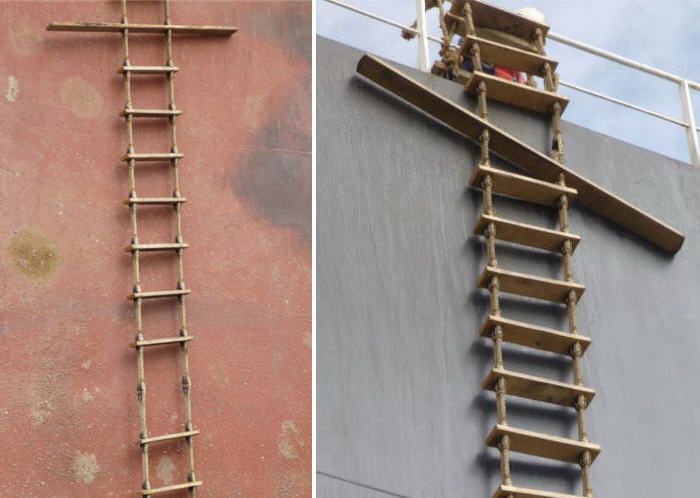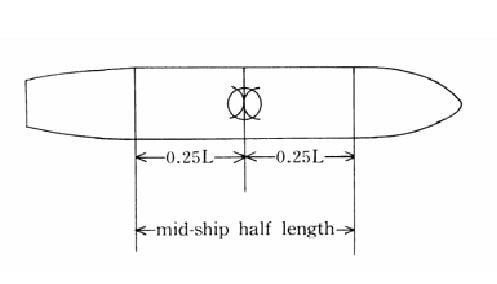Every year pilots are injured and even killed while boarding and disembarking vessels. Such events are not only traumatic, but also come with the consequence of legal liabilities to the vessel.
Ensuring that vessels can be accessed safely is a key loss prevention issue.

Defective pilot ladders in use
Introduction
Pilots come aboard ships to ensure the safe arrival and departure of vessels from ports about which they possess particular local knowledge. Pilots usually board and disembark the vessel via a traditional rope ladder due to the lack of other alternatives.
In some circumstances this can be extremely dangerous and has resulted in a number of deaths and serious accidents. In addition to personal injury claims that arise from defective pilot transfer arrangements, pilots also have the right to refuse to use defective ladders which may significantly delay the vessel.
Pilots may also choose to report defective ladders to port state control authorities which may also cause delays and possible financial penalties. Therefore, in order to reduce claims and delays arising from pilot transfer arrangements, it is important to ensure compliance with all requirements.
A high proportion of accidents to pilots occur at the top of the pilot ladder due to poorly designed access arrangements or inadequately rigged equipment. Further causes of accidents involving pilot ladders include:
- defects in the ladder treads and/or side ropes; and
- lack of proper attachment of the ladder to the vessel
The condition of the pilot ladder should be regularly checked by a competent person prior to rigging to prevent accidents.
Guidance
- The primary requirements for the rigging of pilot transfer arrangements are detailed in Regulation No. 23, Chapter V of the Safety of Life at Sea Convention (SOLAS) 1974, as amended. New SOLAS requirements have come into force from 1 July 2012 and ships constructed after this date must comply with these new equipment and arrangement requirements. Equipment and arrangements replaced on or after 1 July 2012 must also comply with the new requirements, so far as is reasonable and practical.
- The technical specification for ship’s pilot ladders is set out in the International Maritime Organization (IMO) Resolution A.1045(27).
Safe rigging considerations
When rigging pilot ladders, the following considerations must be kept in mind:
- The pilot ladder should be situated on the side of the vessel and at a height above the water in accordance with the pilot’s instructions.
- The pilot ladder should be rigged in an appropriate place, along the parallel body of the vessel and, as far as is practicable, within the mid-ship half length.
- The pilot ladder should be properly secured to the vessel in way of pad eyes or similar. The appliance should not be fastened to ship’s side rails.
- The rigged pilot ladder should be situated near a gate through the side rails or a bulwark ladder should be placed adjacent to the top of the pilot ladder.
- A simple load test should be carried out once the pilot ladder is rigged to ensure that it is properly secured to the ship. Seafarers are reminded to ensure their own safety in doing so by wearing a suitable floatation device and/or lifeline.
- Means should be provided to ensure safe, appropriate and unobstructed passage for pilots embarking on or disembarking from the ship between the head of the pilot ladder or accommodation ladder.
- If the distance from the waterline to the boarding point exceeds nine metres, then a combination arrangement i.e. the accommodation ladder combined with a pilot ladder, must be used.

Diagram of mid-ship half length
Management considerations
Shipowners / technical managers should ensure that:
- Seafarers are appropriately trained in the correct rigging of pilot transfer arrangements;
- Supplied pilot ladders are compliant with SOLAS;
- The inspection and maintenance regime of pilot transfer arrangements are up to date and documented;
- A replacement ladder is available on board the vessel.
On board considerations
- The rigging of the pilot ladder should be supervised by a responsible officer.
- The embarkation / disembarkation of pilots should be closely monitored by a responsible officer, ensuring that SOLAS requirements are observed.
- A lee should be provided for the pilot launch and subsequently maintained until the pilot launch is well clear of the ship.
Credits to: Paul Davidson, Master Mariner
+ 65 6539 0540 / paul.davidson@brookesbell.com
Brookes Bell Singapore, www.brookesbell.com